Planning your PhD research: A 3-year PhD timeline example
Planning out a PhD trajectory can be overwhelming. Example PhD timelines can make the task easier and inspire. The following PhD timeline example describes the process and milestones of completing a PhD within 3 years.

Elements to include in a 3-year PhD timeline
The example scenario: completing a phd in 3 years, example: planning year 1 of a 3-year phd, example: planning year 2 of a 3-year phd, example: planning year 3 of a 3-year phd, example of a 3 year phd gantt chart timeline, final reflection.
Every successful PhD project begins with a proper plan. Even if there is a high chance that not everything will work out as planned. Having a well-established timeline will keep your work on track.
What to include in a 3-year PhD timeline depends on the unique characteristics of a PhD project, specific university requirements, agreements with the supervisor/s and the PhD student’s career ambitions.
For instance, some PhD students write a monograph while others complete a PhD based on several journal publications. Both monographs and cumulative dissertations have advantages and disadvantages , and not all universities allow both formats. The thesis type influences the PhD timeline.
Furthermore, PhD students ideally engage in several different activities throughout a PhD trajectory, which link to their career objectives. Regardless of whether they want to pursue a career within or outside of academia. PhD students should create an all-round profile to increase their future chances in the labour market. Think, for example, of activities such as organising a seminar, engaging in public outreach or showcasing leadership in a small grant application.
The most common elements included in a 3-year PhD timeline are the following:
- Data collection (fieldwork, experiments, etc.)
- Data analysis
- Writing of different chapters, or a plan for journal publication
- Conferences
- Additional activities
The whole process is described in more detail in my post on how to develop an awesome PhD timeline step-by-step .
Many (starting) PhD students look for examples of how to plan a PhD in 3 years. Therefore, let’s look at an example scenario of a fictional PhD student. Let’s call her Maria.
Maria is doing a PhD in Social Sciences at a university where it is customary to write a cumulative dissertation, meaning a PhD thesis based on journal publications. Maria’s university regulations require her to write four articles as part of her PhD. In order to graduate, one article has to be published in an international peer-reviewed journal. The other three have to be submitted.
Furthermore, Maria’s cumulative dissertation needs an introduction and conclusion chapter which frame the four individual journal articles, which form the thesis chapters.
In order to complete her PhD programme, Maria also needs to complete coursework and earn 15 credits, or ECTS in her case.
Maria likes the idea of doing a postdoc after her graduation. However, she is aware that the academic job market is tough and therefore wants to keep her options open. She could, for instance, imagine to work for a community or non-profit organisation. Therefore, she wants to place emphasis on collaborating with a community organisation during her PhD.
You may also like: Creating awesome Gantt charts for your PhD timeline
Most PhD students start their first year with a rough idea, but not a well-worked out plan and timeline. Therefore, they usually begin with working on a more elaborate research proposal in the first months of their PhD. This is also the case for our example PhD student Maria.
- Months 1-4: Maria works on a detailed research proposal, defines her research methodology and breaks down her thesis into concrete tasks.
- Month 5 : Maria follows a short intensive course in academic writing to improve her writing skills.
- Months 5-10: Maria works on her first journal paper, which is based on an extensive literature review of her research topic. At the end of Month 10, she submits the manuscript. At the same time, she follows a course connected to her research topic.
- Months 11-12: Maria does her data collection.
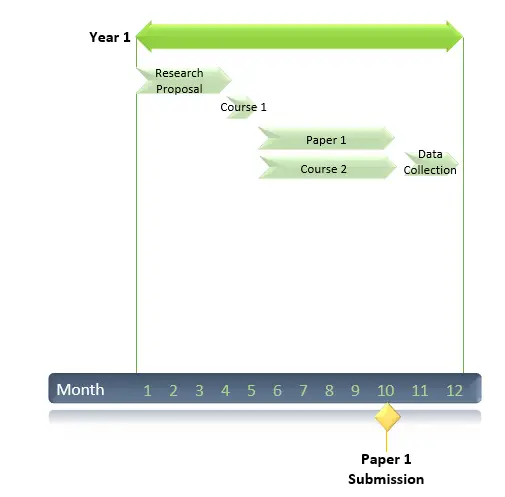
Maria completed her first round of data collection according to plan, and starts the second year of her PhD with a lot of material. In her second year, she will focus on turning this data into two journal articles.
- Months 1-2: Maria works on her data analysis.
- Months 3-7: Maria works on her second journal paper.
- Month 7: Maria attends her first conference, and presents the results of her literature-review paper.
- Month 8: Maria received ‘major revisions’ on her first manuscript submission, and implements the changes in Month 8 before resubmitting her first journal paper for publication.
- Month 9: Maria follows a course on research valorisation to learn strategies to increase the societal impact of her thesis.
- Months 9-12: Maria works on her third journal paper. She uses the same data that she collected for the previous paper, which is why she is able to complete the third manuscript a bit faster than the previous one.
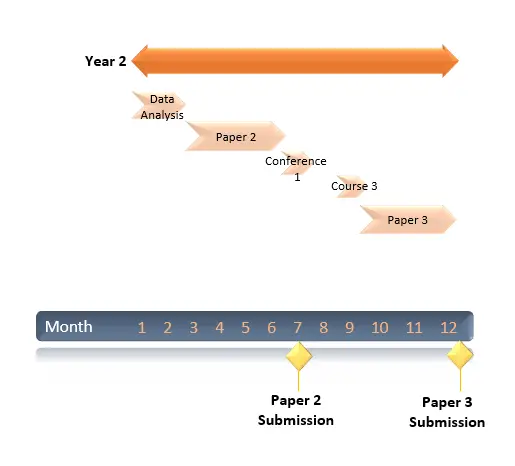
Time flies, and Maria finds herself in the last year of her PhD. There is still a lot of work to be done, but she sticks to the plan and does her best to complete her PhD.
- Month 1: Maria starts a second round of data collection, this time in collaboration with a community organisation. Together, they develop and host several focus groups with Maria’s target audience.
- Month 2: Maria starts to analyse the material of the focus group and develops the argumentation for her fourth journal paper.
- Month 3: Maria presents the results of her second journal paper at an international conference. Furthermore, she helps out her supervisor with a grant application. They apply for funding to run a small project that is thematically connected to her PhD.
- Months 4-9: Maria writes her fourth and final journal article that is required for her PhD.
- Month 10: Maria writes her thesis introduction .
- Month 11: Maria works on her thesis conclusion.
- Month 12 : Maria works on the final edits and proof-reading of her thesis before submitting it.
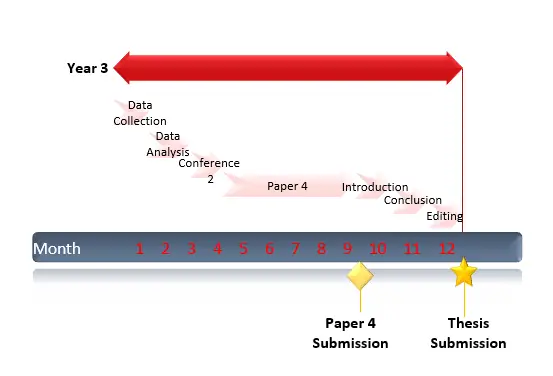
Combining the 3-year planning for our example PhD student Maria, it results in the following PhD timeline:
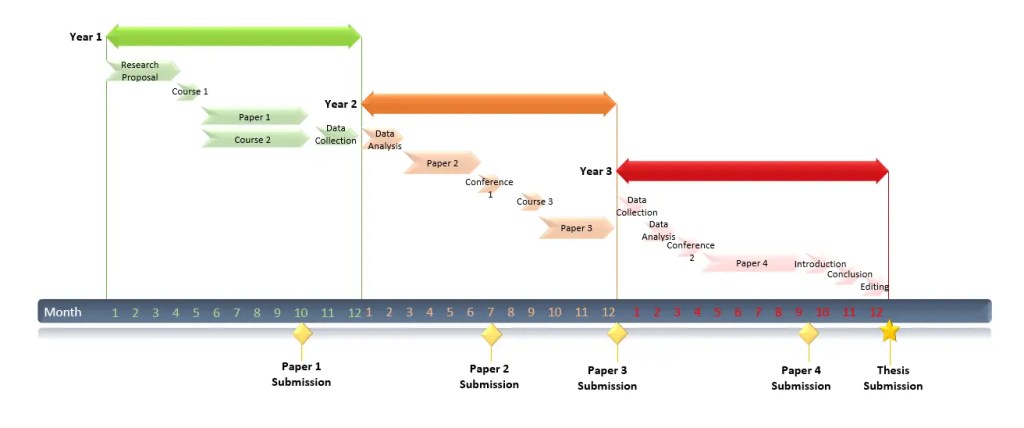
Creating these PhD timelines, also called Gantt charts, is easy. You can find instructions and templates here.
Completing a PhD in 3 years is not an easy task. The example of our fictional PhD student Maria shows how packed her timeline is, and how little time there is for things to go wrong.
In fact, in real life, many PhD students spend four years full-time to complete a PhD based on four papers, instead of three. Some extend their studies even longer.
Furthermore, plan in some time for thesis editing, which is a legitimate practice and can bring your writing to the next level. Finding a reputable thesis editor can be challenging, so make sure you make an informed choice.
Finishing a PhD in 3 years is not impossible, but it surely is not easy. So be kind to yourself if things don’t work out entirely as planned, and make use of all the help you can get.
Master Academia
Get new content delivered directly to your inbox.
Subscribe and receive Master Academia's quarterly newsletter.
10 amazing benefits of getting a PhD later in life
How to prepare your viva opening speech, related articles.

A comprehensive guide to part-time PhDs
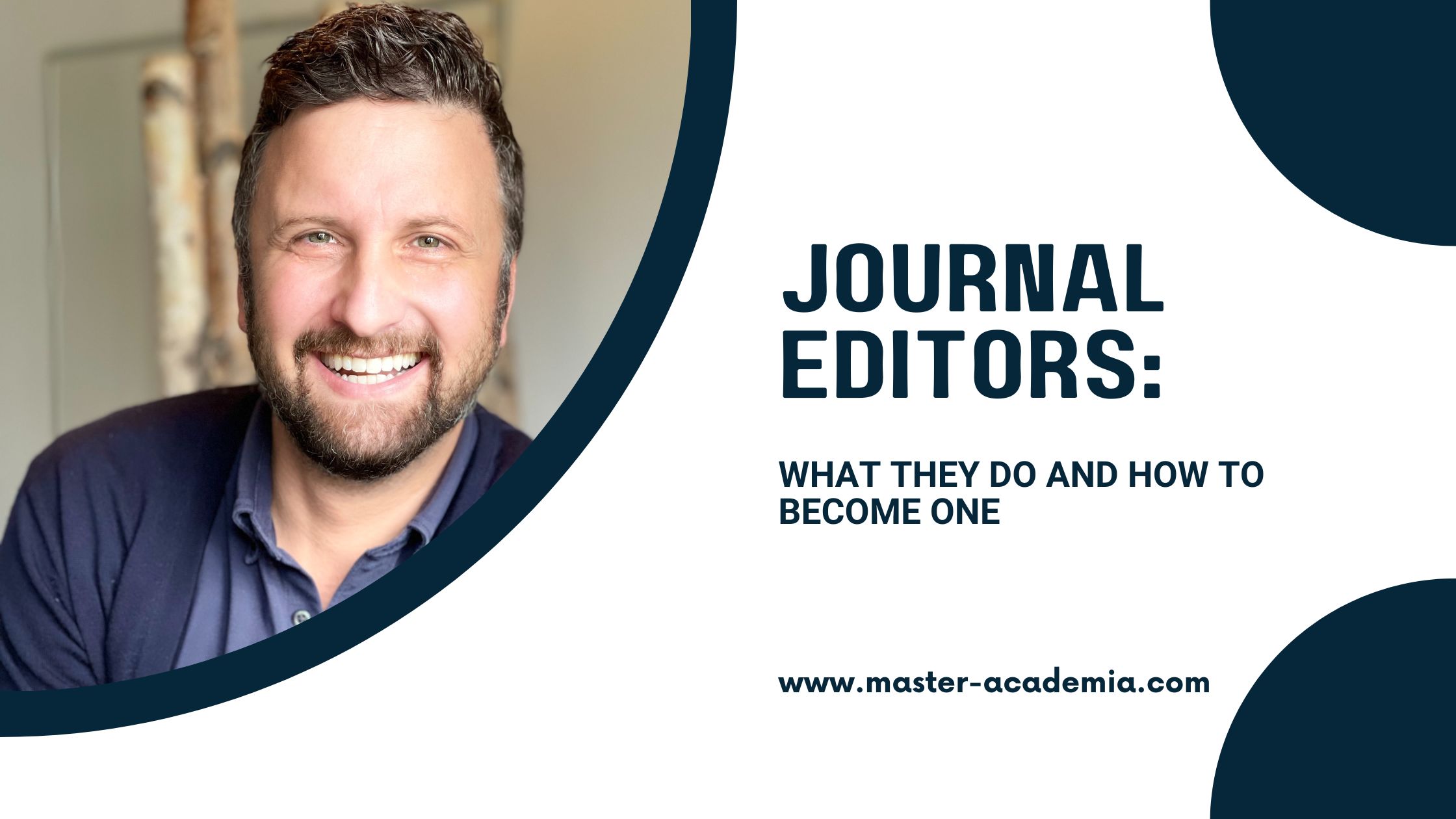
Journal editors: What they do, and how to become one

Funding sources for PhD studies in Europe

Top 20 motivational quotes for PhD students
- eSignatures
- Product updates
- Document templates
How to nail your PhD proposal and get accepted
Bethany Fagan Head of Content Marketing at PandaDoc
Reviewed by:
Olga Asheychik Senior Web Analytics Manager at PandaDoc
- Copy Link Link copied
A good PhD research proposal may be the deciding factor between acceptance and approval into your desired program or finding yourself back at the drawing board. Being accepted for a PhD placement is no easy task, and this is why your PhD proposal needs to truly stand out among a sea of submissions.
That’s why a PhD research proposal is important: It formally outlines the intended research, including methodology, timeline, feasibility, and many other factors that need to be taken into consideration.
Here is a closer look at the PhD proposal process and what it should look like.
→DOWNLOAD NOW: FREE PHD PROPOSAL TEMPLATE
Key takeaways
- A PhD proposal summarizes the research project you intend to conduct as part of your PhD program.
- These proposals are relatively short (1000-2000 words), and should include all basic information and project goals, including the methodologies/strategies you intend to use in order to accomplish them.
- Formats are varied. You may be able to create your own formats, but your college or university may have a required document structure that you should follow.
What is a PhD proposal?
In short, a PhD research proposal is a summary of the project you intend to undertake as part of your PhD program.
It should pose a specific question or idea, make a case for the research, and explain the predicted outcomes of that research.
However, while your PhD proposal may predict expected outcomes, it won’t fully answer your questions for the reader.
Your research into the topic will provide that answer.
Usually, a PhD proposal contains the following elements:
- A clear question that you intend to answer through copious amounts of study and research.
- Your plan to answer that question, including any methodologies, frameworks, and resources required to adequately find the answer.
- Why your question or project is significant to your specific field of study.
- How your proposal impacts, challenges, or improves the existing body of knowledge around a given topic.
- Why your work is important and why you should be the one to receive this opportunity.
In terms of length when writing a PhD proposal, there isn’t a universal answer.
Some institutions will require a short, concise proposal (1000 words), while others allow for a greater amount of flexibility in the length and format of the proposal.
Fortunately, most institutions will provide some guidelines regarding the format and length of your research proposal, so you should have a strong idea of your requirements before you begin.
Benefits of a strong PhD application
While the most obvious benefit of having a strong PhD application is being accepted to the PhD program , there are other reasons to build the strongest PhD application you can:
Better funding opportunities
Many PhD programs offer funding to students , which can be used to cover tuition fees and may provide a stipend for living expenses.
The stronger your PhD application, the better your chances of being offered funding opportunities that can alleviate financial burdens and allow you to focus on your research.
Enhanced academic credentials
A strong PhD application, particularly in hot-button areas of study, can lead to better career opportunities in academics or across a variety of industries.
Opportunities for networking and research
Research proposals that are very well grounded can provide footholds to networking opportunities and mentorships that would not be otherwise available.
However, creating an incredible proposal isn’t always easy.
In fact, it’s easy to get confused by the process since it requires a lot of procedural information.
Many institutions also place a heavy emphasis on using the correct proposal structure.
That doesn’t have to be the issue, though.
Often, pre-designed templates, like the PandaDoc research proposal templates or PhD proposal templates provided by the institution of your choice, can do most of the heavy lifting for you.
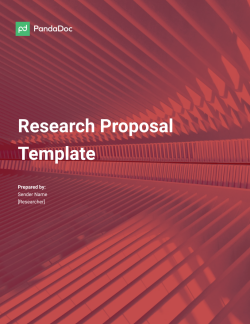
Research Proposal Template
Used 7990 times
4.3 rating (23 reviews)
Legally reviewed by Olga Asheychik
How to write a Phd proposal with a clear structure
We know that the prospect of writing a research proposal for PhD admission may appear the stuff of nightmares. Even more so if you are new to producing a piece such as this.
But, when you get down to the nitty gritty of what it is, it really isn’t so intimidating. When writing your PhD proposal you need to show that your PhD is worth it, achievable, and that you have the ability to do it at your chosen university.
With all of that in mind, let’s take a closer look at each section of a standard PhD research proposal and the overall structure.
1. Front matter
The first pages of your PhD proposal should outline the basic information about the project. That will include each of the following:
Project title
Typically placed on the first page, your title should be engaging enough to attract attention and clear enough that readers will understand what you’re trying to achieve.
Many proposals also include a secondary headline to further (concisely) clarify the main concept.
Contact information
Depending on the instructions provided by your institution, you may need to include your basic contact information with your proposal.
Some institutions may ask for blind submissions and ask that you omit identifying information, so check the program guidelines to be sure.
Research supervisor
If you already have a supervisor for the project, you’ll typically want to list that information.
Someone who is established in the field can add credibility to your proposal, particularly if your project requires extensive funding or has special considerations.
The guidelines from your PhD program should provide some guidance regarding any other auxiliary information that you should add to the front of your proposal.
Be sure to check all documentation to ensure that everything fits into the designated format.
2. Goals, summaries, and objectives
Once you’ve added the basic information to your document, you’ll need to get into the meat of your PhD proposal.
Depending on your institution, your research proposal may need to follow a rigid format or you may have the flexibility to add various sections and fully explain your concepts.
These sections will primarily be focused on providing high-level overviews surrounding your PhD proposal, including most of the following:
Overall aims, objectives, and goals
In these sections, you’ll need to state plainly what you aim to accomplish with your PhD research.
If awarded funding, what questions will your PHd proposal seek to answer? What theories will you test? What concepts will you explore in your research?
Briefly, how would you summarize your approach to this project?
Provide high-level summaries detailing how you mean to achieve your answers, what the predicted outcomes of your PhD research might be, and precisely what you intend to test or discover.
Significance
Why does your research matter? Unlike with many other forms of academic study (such as a master’s thesis ), doctorate-level research often pushes the bounds of specific fields or contributes to a given body of work in some unique way.
How will your proposed PhD research do those things?
Background details
Because PhD research is about pushing boundaries, adding background context regarding the current state of affairs in your given field can help readers better understand why you want to pursue this research and how you arrived at this specific point of interest.
While the information here may (or may not) be broken into multiple sections, the content here is largely designed to provide a high-level overview of your PhD proposal and entice readers to dig deeper into the methodologies and angles of approach in future sections.
Because so much of this section relies on the remainder of your document, it’s sometimes better to skip this portion of the PhD proposal until the later sections are complete and then circle back to it.
That way, you can provide concise summaries that refer to fully defined research methods that you’ve already explained in subsequent areas.
3. Methodologies and plans
Unlike a master’s thesis or a similar academic document, PhD research is designed to push the boundaries of its subject matter in some way.
The idea behind doctoral research is to expand the field with new insights and viewpoints that are the culmination of years of research and study, combined with a deep familiarity of the topic at hand.
The methodologies and work plans you provide will give advisors some insights into how you plan to conduct your research.
While there is no one right way to develop this section, you’ll need to include a few key details:
Research methods
Are there specific research methods you plan to use to conduct your PhD research?
Are you conducting experiments? Conducting qualitative research? Surveying specific individuals in a given environment?
Benefits and drawbacks of your approach
Regardless of your approach to your topic, there will be upsides and downsides to that methodology.
Explain what you feel are the primary benefits to your research method, where there are potential flaws, and how you plan to account for those shortfalls.
Choice of methodology
Why did you choose a given methodology?
What makes it the best method (or collection of methods) for your research and/or specific use case?
Outline of proposed work
What work is required for PhD research to be complete?
What steps will you need to take in order to capture the appropriate information? How will you complete those steps?
Schedule of work (including timelines/deadlines)
How long will it take you to complete each stage or step of your project?
If your PhDproject will take several years, you may need to provide specifics for more immediate timelines up front while future deadlines may be flexible or estimated.
There is some flexibility here.
It’s unlikely that your advisors will expect you to have the answer for every question regarding how you plan to approach your body of research.
When trying to push the boundaries of any given topic, it’s expected that some things may not go to plan.
However, you should do your best to make timelines and schedules of work that are consistent with your listed goals.
Remember : At the end of your work, you are expected to have a body of original research that is complete within the scope and limitations of the PhD proposal you set forth.
If your advisors feel that your subject matter is too broad, they may encourage you to narrow the scope to better fit into more standardized expectations.
4. Resources and citations
No PhD research proposal is complete without a full list of the resources required to carry out the project and references to help prove and validate the research.
Here’s a closer look at what you’ll need to submit in order to explain costs and prove the validity of your proposal:
Estimated costs and resources
Most doctoral programs offer some level of funding for these projects.
To take advantage of those funds, you’ll need to submit a budget of estimated costs so that assessors can better understand the financial requirements.
This might include equipment, expenses for fieldwork or travel, and more.
Citations and bibliographies
No matter your field of study, doctoral research is built on the data and observations provided by past contributors.
Because of this, you’ll need to provide citations and sources referenced in your PhD proposal documentation.
Particularly when it comes to finances and funding, it might be tempting to downplay the cost of the project.
However, it’s best to provide a realistic estimate in terms of costs so that you have enough of a budget to cover the PhD research.
Adjustments can be made at a later date, particularly as you conduct more research and dive further into the project.
Resources are often presented in the form of a table to make things easier to track and identify.
Using PhD proposal templates
Aside from any guidelines set forth by your institution, there are no particularly strict rules when it comes to the format of PhD proposals.
Your supervisor will be more than capable of guiding you through the process.
However, since everything is so structured and formal, you might want to use a PhD proposal template to help you get started.
Templates can help you stay on track and make sure your research proposal follows a certain logic.
A lot of proposal software solutions offer templates for different types of proposals, including PhD proposals.
But, should you use Phd proposal templates? Here are some pros and cons to help you make a decision.
- Expedites the proposal process.
- Helps you jumpstart the process with a flexible document structure.
- Often provides sections with pre-filled examples.
- Looks better than your average Word document.
- May be limiting if you adhere to it too much.
- Might not be perfectly suited to your specific field of research, requiring some customization.
In our PhD research proposal template , we give you just enough direction to help you follow through but we don’t limit your creativity to a point that you can’t express yourself and all the nuances of your research.
For almost all sections, you get a few useful PhD research proposal examples to point you in the right direction.
The template provides you with a typical PhD proposal structure that’s perfect for almost all disciplines.
It can come in quite handy when you have everything planned out in your head but you’re just having trouble putting it onto the page!
Writing a PhD proposal that convinces
Writing and completing a PhD proposal might be confusing at first.
You need to follow a certain logic and share all the required information without going too long or sharing too much about the project.
And, while your supervisor will certainly be there to guide you, the brunt of the work will still fall on your shoulders.
That’s why you need to stay informed, do your research, and don’t give up until you feel comfortable with what you’ve created.
If you want to get a head start, you might want to consider our research proposal template .
It will offer you a structure to follow when writing a PhD proposal and give you an idea on what to write in each section.
Start your 14 days trial with PandaDoc and check out all the tools you’ll have at your disposal!
Research proposals for PhD admission: tips and advice
One of the most important tips for any piece of writing is to know your audience. The staff reviewing your PhD proposal are going through a pile of them, so you need to make sure yours stands within a few seconds of opening it.
The way to do this is by demonstrating value and impact. Academic work is often written for a niche community of researchers in one field, so you need to demonstrate why your work would be valuable to people in that area.
The people reviewing your proposal will likely be in that field. So your proposal should be a little like a sales pitch: you need to write something engaging that identifies with the “customer”, speaks to a problem they’re having, and shows them a solution.
Taking some inspiration from the former University of Chicago professor Larry McEnerney , here are some ideas to keep in mind…
- It’s common for undergraduates and even seasoned academics to write in a specific format or style to demonstrate their understanding and signal that they’re part of the academic community. Instead, you want to write in such a way that actually engages the reader.
- Identify an uncharted or underexplored knowledge gap in your field, and show the reader you have what it takes to fill in that gap.
- Challenge the status quo. Set up an idea that people in your field take for granted — maybe a famous study you think is flawed — and outline how your project could knock it down.
- This is why it’s important to understand who your audience is. You have to write your proposal in such a way that it’s valuable for reviewers. But within your proposal, you should also clearly define which community of researchers your project is for, what problems they have, and how your project is going to solve those problems.
- Every community of researchers has their own implicit “codes” and “keywords” that signal understanding. These will be very different in each field and could be very subtle. But just by reading successful PhD research proposal examples in your field, you can get a sense of what those are and decide how you want to employ them in your own work.
- In this model authors start “at the bottom of the glass” with a very narrow introduction to the idea of the paper, then “fill the glass” with a broader and broader version of the same idea.
- Instead, follow a “problem-solution” framework. Introduce a problem that’s relevant to your intended reader, then offer a solution. Since “solutions” often raise their own new problems or questions, you can rinse and repeat this framework all the way through any section of your proposal.
But how can you apply that advice? If you’re following something like our research proposal template , here are some actionable ways to get started.
- Your title should be eye-catching , and signal value by speaking to either a gap in the field or challenging the status quo.
- Your abstract should speak to a problem in the field, one the reviewers will care about, and clearly outline how you’d like to solve it.
- When you list the objectives of your proposal , each one should repeat this problem-solution framework. You should concretely state what you want to achieve, and what you’re going to do to achieve it.
- While you survey your chosen field in the literature review, you should refer back to the knowledge gap or status quo that you intend to work on. This reinforces how important your proposed project is, and how valuable it would be to the community if your project was successful.
- While listing your research limitations , try to hint at new territory researchers might be able to explore off the back of your work. This illustrates that you’re proposing boundary-pushing work that will really advance knowledge of the field.
- While you’re outlining your funding requirements , be clear about why each line item is necessary and bring it back to the value of your proposed research. Every cent counts!
Frequently asked questions
How long should a phd proposal be.
There really isn’t a specific rule when it comes to the length of a PhD proposal. However, it’s generally accepted that it should be between 1,000 and 2,000 words.
It’s difficult to elaborate on such a serious project in less than 1,000 words but going over 2,000 is often overkill. You’ll lose people’s attention and water down your points.
What’s the difference between a dissertation proposal and a PhD proposal?
There seems to be some confusion over the terms “dissertation” and “PhD” and how you write proposals for each one. However, “dissertation” is just another name for your PhD research so the proposal for a dissertation would be the same since it’s quite literally the same thing.
Does a PhD proposal include budgeting?
Yes, as mentioned, you need to demonstrate the feasibility of your project within the given time frame and with the resources you need, including budgets. You don’t need to be exact, but you need to have accurate estimates for everything.
How is a PhD proposal evaluated?
This will change from one institution to another but these things will generally have a big impact on the reviewers:
- The contribution of the project to the field.
- Design and feasibility of the project.
- The validity of the methodology and objectives.
- The supervisor and their role in the field.
PandaDoc is not a law firm, or a substitute for an attorney or law firm. This page is not intended to and does not provide legal advice. Should you have legal questions on the validity of e-signatures or digital signatures and the enforceability thereof, please consult with an attorney or law firm. Use of PandaDocs’ services are governed by our Terms of Use and Privacy Policy.
Originally published June 9, 2023, updated February 6, 2024
Related articles

Proposals 24 min

Sales 5 min

Document templates 13 min
How to write a research proposal
What is a research proposal.
A research proposal should present your idea or question and expected outcomes with clarity and definition – the what.
It should also make a case for why your question is significant and what value it will bring to your discipline – the why.
What it shouldn't do is answer the question – that's what your research will do.
Why is it important?
Research proposals are significant because Another reason why it formally outlines your intended research. Which means you need to provide details on how you will go about your research, including:
- your approach and methodology
- timeline and feasibility
- all other considerations needed to progress your research, such as resources.
Think of it as a tool that will help you clarify your idea and make conducting your research easier.
How long should it be?
Usually no more than 2000 words, but check the requirements of your degree, and your supervisor or research coordinator.
Presenting your idea clearly and concisely demonstrates that you can write this way – an attribute of a potential research candidate that is valued by assessors.
What should it include?
Project title.
Your title should clearly indicate what your proposed research is about.
Research supervisor
State the name, department and faculty or school of the academic who has agreed to supervise you. Rest assured, your research supervisor will work with you to refine your research proposal ahead of submission to ensure it meets the needs of your discipline.
Proposed mode of research
Describe your proposed mode of research. Which may be closely linked to your discipline, and is where you will describe the style or format of your research, e.g. data, field research, composition, written work, social performance and mixed media etc.
This is not required for research in the sciences, but your research supervisor will be able to guide you on discipline-specific requirements.
Aims and objectives
What are you trying to achieve with your research? What is the purpose? This section should reference why you're applying for a research degree. Are you addressing a gap in the current research? Do you want to look at a theory more closely and test it out? Is there something you're trying to prove or disprove? To help you clarify this, think about the potential outcome of your research if you were successful – that is your aim. Make sure that this is a focused statement.
Your objectives will be your aim broken down – the steps to achieving the intended outcome. They are the smaller proof points that will underpin your research's purpose. Be logical in the order of how you present these so that each succeeds the previous, i.e. if you need to achieve 'a' before 'b' before 'c', then make sure you order your objectives a, b, c.
A concise summary of what your research is about. It outlines the key aspects of what you will investigate as well as the expected outcomes. It briefly covers the what, why and how of your research.
A good way to evaluate if you have written a strong synopsis, is to get somebody to read it without reading the rest of your research proposal. Would they know what your research is about?
Now that you have your question clarified, it is time to explain the why. Here, you need to demonstrate an understanding of the current research climate in your area of interest.
Providing context around your research topic through a literature review will show the assessor that you understand current dialogue around your research, and what is published.
Demonstrate you have a strong understanding of the key topics, significant studies and notable researchers in your area of research and how these have contributed to the current landscape.
Expected research contribution
In this section, you should consider the following:
- Why is your research question or hypothesis worth asking?
- How is the current research lacking or falling short?
- What impact will your research have on the discipline?
- Will you be extending an area of knowledge, applying it to new contexts, solving a problem, testing a theory, or challenging an existing one?
- Establish why your research is important by convincing your audience there is a gap.
- What will be the outcome of your research contribution?
- Demonstrate both your current level of knowledge and how the pursuit of your question or hypothesis will create a new understanding and generate new information.
- Show how your research is innovative and original.
Draw links between your research and the faculty or school you are applying at, and explain why you have chosen your supervisor, and what research have they or their school done to reinforce and support your own work. Cite these reasons to demonstrate how your research will benefit and contribute to the current body of knowledge.
Proposed methodology
Provide an overview of the methodology and techniques you will use to conduct your research. Cover what materials and equipment you will use, what theoretical frameworks will you draw on, and how will you collect data.
Highlight why you have chosen this particular methodology, but also why others may not have been as suitable. You need to demonstrate that you have put thought into your approach and why it's the most appropriate way to carry out your research.
It should also highlight potential limitations you anticipate, feasibility within time and other constraints, ethical considerations and how you will address these, as well as general resources.
A work plan is a critical component of your research proposal because it indicates the feasibility of completion within the timeframe and supports you in achieving your objectives throughout your degree.
Consider the milestones you aim to achieve at each stage of your research. A PhD or master's degree by research can take two to four years of full-time study to complete. It might be helpful to offer year one in detail and the following years in broader terms. Ultimately you have to show that your research is likely to be both original and finished – and that you understand the time involved.
Provide details of the resources you will need to carry out your research project. Consider equipment, fieldwork expenses, travel and a proposed budget, to indicate how realistic your research proposal is in terms of financial requirements and whether any adjustments are needed.
Bibliography
Provide a list of references that you've made throughout your research proposal.
Apply for postgraduate study
New hdr curriculum, find a supervisor.
Search by keyword, topic, location, or supervisor name
- 1800 SYD UNI ( 1800 793 864 )
- or +61 2 8627 1444
- Open 9am to 5pm, Monday to Friday
- Student Centre Level 3 Jane Foss Russell Building Darlington Campus
Scholarships
Find the right scholarship for you
Research areas
Our research covers the spectrum – from linguistics to nanoscience
Our breadth of expertise across our faculties and schools is supported by deep disciplinary knowledge. We have significant capability in more than 20 major areas of research.
Research facilities
High-impact research through state-of-the-art infrastructure

How to Write a PhD Research Proposal
- Applying to a PhD
- A research proposal summarises your intended research.
- Your research proposal is used to confirm you understand the topic, and that the university has the expertise to support your study.
- The length of a research proposal varies. It is usually specified by either the programme requirements or the supervisor upon request. 1500 to 3500 words is common.
- The typical research proposal structure consists of: Title, Abstract, Background and Rationale, Research Aims and Objectives, Research Design and Methodology, Timetable, and a Bibliography.
What is a Research Proposal?
A research proposal is a supporting document that may be required when applying to a research degree. It summarises your intended research by outlining what your research questions are, why they’re important to your field and what knowledge gaps surround your topic. It also outlines your research in terms of your aims, methods and proposed timetable .
What Is It Used for and Why Is It Important?
A research proposal will be used to:
- Confirm whether you understand the topic and can communicate complex ideas.
- Confirm whether the university has adequate expertise to support you in your research topic.
- Apply for funding or research grants to external bodies.
How Long Should a PhD Research Proposal Be?
Some universities will specify a word count all students will need to adhere to. You will typically find these in the description of the PhD listing. If they haven’t stated a word count limit, you should contact the potential supervisor to clarify whether there are any requirements. If not, aim for 1500 to 3500 words (3 to 7 pages).
Your title should indicate clearly what your research question is. It needs to be simple and to the point; if the reader needs to read further into your proposal to understand your question, your working title isn’t clear enough.
Directly below your title, state the topic your research question relates to. Whether you include this information at the top of your proposal or insert a dedicated title page is your choice and will come down to personal preference.
2. Abstract
If your research proposal is over 2000 words, consider providing an abstract. Your abstract should summarise your question, why it’s important to your field and how you intend to answer it; in other words, explain your research context.
Only include crucial information in this section – 250 words should be sufficient to get across your main points.

3. Background & Rationale
First, specify which subject area your research problem falls in. This will help set the context of your study and will help the reader anticipate the direction of your proposed research.
Following this, include a literature review . A literature review summarises the existing knowledge which surrounds your research topic. This should include a discussion of the theories, models and bodies of text which directly relate to your research problem. As well as discussing the information available, discuss those which aren’t. In other words, identify what the current gaps in knowledge are and discuss how this will influence your research. Your aim here is to convince the potential supervisor and funding providers of why your intended research is worth investing time and money into.
Last, discuss the key debates and developments currently at the centre of your research area.
4. Research Aims & Objectives
Identify the aims and objectives of your research. The aims are the problems your project intends to solve; the objectives are the measurable steps and outcomes required to achieve the aim.
In outlining your aims and objectives, you will need to explain why your proposed research is worth exploring. Consider these aspects:
- Will your research solve a problem?
- Will your research address a current gap in knowledge?
- Will your research have any social or practical benefits?
If you fail to address the above questions, it’s unlikely they will accept your proposal – all PhD research projects must show originality and value to be considered.
5. Research Design and Methodology
The following structure is recommended when discussing your research design:
- Sample/Population – Discuss your sample size, target populations, specimen types etc.
- Methods – What research methods have you considered, how did you evaluate them and how did you decide on your chosen one?
- Data Collection – How are you going to collect and validate your data? Are there any limitations?
- Data Analysis – How are you going to interpret your results and obtain a meaningful conclusion from them?
- Ethical Considerations – Are there any potential implications associated with your research approach? This could either be to research participants or to your field as a whole on the outcome of your findings (i.e. if you’re researching a particularly controversial area). How are you going to monitor for these implications and what types of preventive steps will you need to put into place?
6. Timetable

We’ve outlined the various stages of a PhD and the approximate duration of a PhD programme which you can refer to when designing your own research study.
7. Bibliography
Plagiarism is taken seriously across all academic levels, but even more so for doctorates. Therefore, ensure you reference the existing literature you have used in writing your PhD proposal. Besides this, try to adopt the same referencing style as the University you’re applying to uses. You can easily find this information in the PhD Thesis formatting guidelines published on the University’s website.
Finding a PhD has never been this easy – search for a PhD by keyword, location or academic area of interest.
Questions & Answers
Here are answers to some of the most common questions we’re asked about the Research Proposal:
Can You Change a Research Proposal?
Yes, your PhD research proposal outlines the start of your project only. It’s well accepted that the direction of your research will develop with time, therefore, you can revise it at later dates.
Can the Potential Supervisor Review My Draft Proposal?
Whether the potential supervisor will review your draft will depend on the individual. However, it is highly advisable that you at least attempt to discuss your draft with them. Even if they can’t review it, they may provide you with useful information regarding their department’s expertise which could help shape your PhD proposal. For example, you may amend your methodology should you come to learn that their laboratory is better equipped for an alternative method.
How Should I Structure and Format My Proposal?
Ensure you follow the same order as the headings given above. This is the most logical structure and will be the order your proposed supervisor will expect.
Most universities don’t provide formatting requirements for research proposals on the basis that they are a supporting document only, however, we recommend that you follow the same format they require for their PhD thesis submissions. This will give your reader familiarity and their guidelines should be readily available on their website.
Last, try to have someone within the same academic field or discipline area to review your proposal. The key is to confirm that they understand the importance of your work and how you intend to execute it. If they don’t, it’s likely a sign you need to rewrite some of your sections to be more coherent.
Browse PhDs Now
Join thousands of students.
Join thousands of other students and stay up to date with the latest PhD programmes, funding opportunities and advice.
- Log in
- Site search
How to write a successful research proposal
As the competition for PhD places is incredibly fierce, your research proposal can have a strong bearing on the success of your application - so discover how to make the best impression
What is a research proposal?
Research proposals are used to persuade potential supervisors and funders that your work is worthy of their support. These documents setting out your proposed research that will result in a Doctoral thesis are typically between 1,500 and 3,000 words in length.
Your PhD research proposal must passionately articulate what you want to research and why, convey your understanding of existing literature, and clearly define at least one research question that could lead to new or original knowledge and how you propose to answer it.
Professor Leigh Wilson, director of the graduate school at the University of Westminster, explains that while the research proposal is about work that hasn't been done yet, what prospective supervisors and funders are focusing on just as strongly is evidence of what you've done - how well you know existing literature in the area, including very recent publications and debates, and how clearly you've seen what's missing from this and so what your research can do that's new. Giving a strong sense of this background or frame for the proposed work is crucial.
'Although it's tempting to make large claims and propose research that sweeps across time and space, narrower, more focused research is much more convincing,' she adds. 'To be thorough and rigorous in the way that academic work needs to be, even something as long as a PhD thesis can only cover a fairly narrow topic. Depth not breadth is called for.'
The structure of your research proposal is therefore important to achieving this goal, yet it should still retain sufficient flexibility to comfortably accommodate any changes you need to make as your PhD progresses.
Layout and formats vary, so it's advisable to consult your potential PhD supervisor before you begin. Here's what to bear in mind when writing a research proposal.
Your provisional title should be around ten words in length, and clearly and accurately indicate your area of study and/or proposed approach. It should be catchy, informative and interesting.
The title page should also include personal information, such as your name, academic title, date of birth, nationality and contact details.
Aims and objectives
This is a short summary of your project. Your aims should be two or three broad statements that emphasise what you ultimately want to achieve, complemented by several focused, feasible and measurable objectives - the steps that you'll take to answer each of your research questions. This involves clearly and briefly outlining:
- how your research addresses a gap in, or builds upon, existing knowledge
- how your research links to the department that you're applying to
- the academic, cultural, political and/or social significance of your research questions.
Literature review
This section of your PhD proposal discusses the most important theories, models and texts that surround and influence your research questions, conveying your understanding and awareness of the key issues and debates.
It should focus on the theoretical and practical knowledge gaps that your work aims to address, as this ultimately justifies and provides the motivation for your project.
Methodology
Here, you're expected to outline how you'll answer each of your research questions. A strong, well-written methodology is crucial, but especially so if your project involves extensive collection and significant analysis of primary data.
In disciplines such as humanities the research proposal methodology identifies the data collection and analytical techniques available to you, before justifying the ones you'll use in greater detail. You'll also define the population that you're intending to examine.
You should also show that you're aware of the limitations of your research, qualifying the parameters that you plan to introduce. Remember, it's more impressive to do a fantastic job of exploring a narrower topic than a decent job of exploring a wider one.
Concluding or following on from your methodology, your timetable should identify how long you'll need to complete each step - perhaps using bi-weekly or monthly timeslots. This helps the reader to evaluate the feasibility of your project and shows that you've considered how you'll go about putting the PhD proposal into practice.
Bibliography
Finally, you'll provide a list of the most significant texts, plus any attachments such as your academic CV . Demonstrate your skills in critical reflection by selecting only those resources that are most appropriate.
Final checks
Before submitting this document along with your PhD application, you'll need to ensure that you've adhered to the research proposal format. This means that:
- every page is numbered
- it's professional, interesting and informative
- the research proposal has been proofread by both an experienced academic (to confirm that it conforms to academic standards) and a layman (to correct any grammatical or spelling errors)
- it has a contents page
- you've used a clear and easy-to-read structure, with appropriate headings.
Research proposal examples
To get a better idea of how your PhD proposal may look, some universities have provided examples of research proposals for specific subjects:
- The Open University - Social Policy and Criminology
- University of Sheffield - Sociological Studies
- University of Sussex
- University of York - Politics
Find out more
- Explore PhD studentships .
- For tips on writing a thesis, see 7 steps to writing a dissertation .
- Read more about PhD study .
How would you rate this page?
On a scale where 1 is dislike and 5 is like
- Dislike 1 unhappy-very
- Like 5 happy-very
Thank you for rating the page

How to Prepare Actionable PhD Research Plan Template
“Where PhD is highly uncertain, an actionable PhD research plan would give you calculative and tentative outcomes. And even more, the ready-to-use template makes things even better. Let’s take a close look at the research plan + template.”
Before moving forward, it’s important to understand the process and steps in research . Then only you can make an actionable plan for your PhD research. It’s literally like driving without breaks— that you don’t want.
In a broader sense, when you plan something, it shows two things: first, you are actually serious about the work you are planning and second, you are expecting some outcomes. And by a plan, you are heading towards it.
I know, plans may not work 100% all the time, but they may create a definite path to achieve at least 80% success in the work you are doing. This is also true for a PhD— in which you would constantly try to justify a single sentence– your research title.
So– Yes, the research process is undetermined and so the results too! but here is the catch and perhaps answer why you have to have a research plan. In this article, I will explain the importance of a research plan, an actionable research plan and a ready-to-use template for you.
How to prepare an actionable research plan?
Importance of phd research plan , wrapping up.
An actionable research plan is what you have to rely upon. So it should be perfect and approved. how can you prepare your own? Let’s see.
Understand the steps in the research and closely follow them.
Define the objectives and scope of your study.
Define each goal of your study– For example, sample collection, wet lab work, standardization, experimentation, data collection and interpretation, etc.
Enlist what types of problems you may face for each goal– For example, transportation for sample collection, Lack of facilities in wet lab work, etc.
Find a solution for each problem you have enlisted– For example, appoint an expert for sample collection and transport samples in a cold chain. If your lab doesn’t have some instruments or chemicals, priorly contact other labs and ask them for help.
Draw a rough road map for your work— the route using which you will achieve your research goals. Also, make a backup. What if the route or process you selected would not work? Check out this drawing to understand my point.
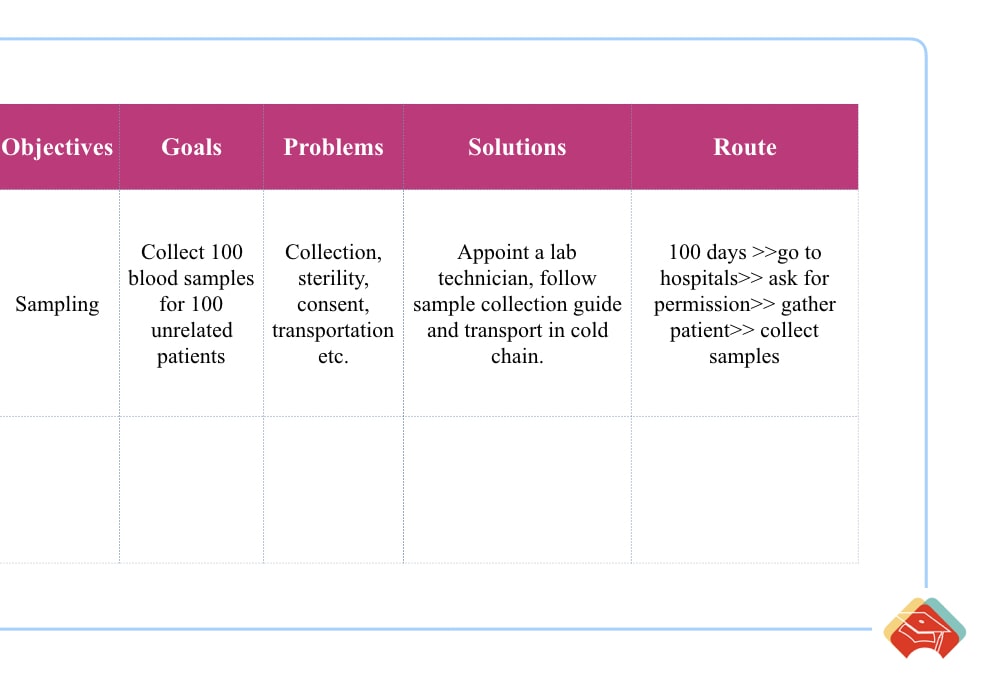
Now prepare a timeline— in how much time a particular goal should be achieved. For example, 6 Months for sampling (Including, ethical approval, approval from sampling authority, consent, preparation and arrangement for utilities).
Another is sample collection— 3 Months which isn’t covered in the 6 months of sampling objective, like this. Take a look at the drawing here.
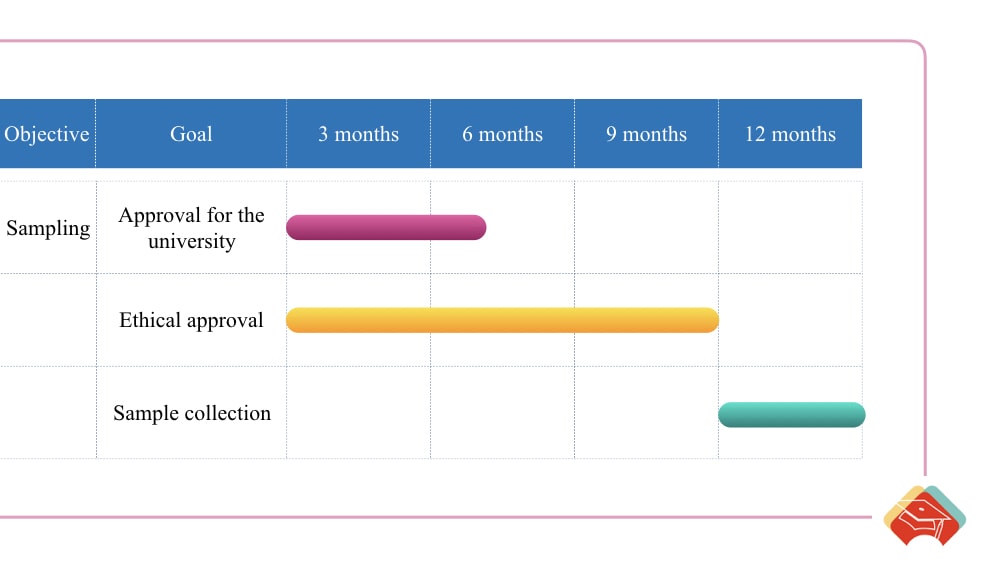
Note: This timeline must match with your GANTT chart for PhD timeline because you are making an actionable plan.
Now your plan is reading. You are now aware of each objective, goal and problem. Some you probably solved, and some you can manage later. This you can print and stitch in your logbook or can save on your desktop.
Take a look at the advantages, and why it’s important to prepare an action plan.
Related article: How to Prepare a PhD Research Plan/Schedule?
Let’s start with two real-world examples first.
One of my friends, after sample collection and initiating the testing, found out that she also has to perform hormone assays for samples. The samples she collected are 3 months old— not possible to assess quantitative analysis.
Another colleague after sample collection– when he started working in the wet lab, came to know that one important instrument is not there in their lab. His guide is very serious about the goal that they have to do it anyhow.
He sent applications to various universities and research centers to work on that particular instrument. From approval to real testing, it tools all almost 8 months including, approval, training, transportation, etc.
Wasted much time!
- An actionable research plan saves your time— which is a crucial factor in PhD.
- It makes you aware of the pros and cons of your study.
- It makes you aware of the problems and limitations of the research you conduct.
- It gives you a broad roadmap to achieve your PhD in “some” tentative time.
- It gives you the flexibility to achieve goals and enjoy your time at the same time.
- You can make real-time monitoring of how your research is going and how much work is left.
- It makes you aware of what should be your next move and the preparations you required.
However, keep in mind that once you prepare a plan, review it from your guide, take their advice, enlist major objectives and techniques you would use for the study and stick to it.
Before preparing that, read the literature regarding your topic and understand the way in which your research should be headed.
Check out our fully customizable, ready-to-use and actionable research plan template.
Download a research plan template
These things look a bit old school but it works, really works well. Most students don’t do it and end up messing things and at last, came to know that they wasted their time. At least, the research plan will tell you where you are stuck (probably) and you can find a solution.
We know how hard it is to predict the future of PhD or how it would go. But let me tell you, with an actionable plan, many do well. And you can too. Take your doctorate seriously from day one. And do accordingly.
Remember your goal should be to complete your degree in time.

Dr. Tushar Chauhan is a Scientist, Blogger and Scientific-writer. He has completed PhD in Genetics. Dr. Chauhan is a PhD coach and tutor.
Share this:

- Share on Facebook
- Share on Twitter
- Share on Pinterest
- Share on Linkedin
- Share via Email
About The Author

Dr Tushar Chauhan
Related posts.

A Definite Research Process for PhD- What Students Should Know?

What are Research- Aim, Objectives, Tasks/Goals? [Our System]
Leave a comment cancel reply.
Your email address will not be published. Required fields are marked *
Save my name, email, and website in this browser for the next time I comment.
Notify me of follow-up comments by email.
Notify me of new posts by email.
PhD Research Proposal Template With Examples
23/02/2023 Emily Watson
A comprehensive research proposal is one of the most important parts of your PhD application, as it explains what you plan to research, what your aims and objectives are, and how you plan to meet those objectives.
Below you will find a research proposal template you can use to write your own PhD proposal, along with examples of specific sections. Note that your own research proposal should be specific and carefully tailored to your own project and no two proposals look the same. Use the template and examples below with that in mind.
If you’re looking for more detailed information on how to write a PhD research proposal, read our full guide via the button below.
How to write a PhD research proposal
Research Proposal Template
The template below is one way you could consider structuring your research proposal to ensure that you include all of the relevant information about your project. However, each university publishes its own guidance on what to include in a proposal, so always make sure you are meeting their specific criteria.
Your proposal should typically be written in size 12 font and limited to around 15 pages in length.
Date Title of Your Research Project (or proposed title) Your name Supervisor’s name (if known) Department
Contents Introduction… Page 3 Research aims… Page 4 Literature review… Page 5 Research methods/methodology… Page 7 Outcomes and impact… Page 8 Budget… Page 9 Schedule… Page 9 References/Bibliography… Page 10
Introduction Introduce your research proposal with a brief overview of your intended research. Include the context and background of the research topic, as well as the rationale for undertaking the research. You should also reference key literature and include any relevant previous research you have done personally.
Research aims The aims of your research relate to the purpose of conducting the research and what you specifically want to achieve. Your research questions should be formulated to show how you will achieve those aims and what you want to find out through your research. “The objectives of this research project are to…..” “The following tasks will be undertaken as a part of the proposed research: Task 1 Task 2 Task 3, etc.”
Literature review Identify and expand on the key literature relating to your research topic. You will need to not only provide individual studies and theories, but also critically analyse and evaluate this literature.
Research methods/methodology Explain how you plan to conduct your research and the practical and/or theoretical approaches you will take. Describe and justify a sample/participants you plan to use, research methods and models you plan on implementing, and plans for data collection and data analysis. Also, consider any hurdles you may encounter or ethical considerations you need to make.
Outcomes and impact You don’t need to identify every specific/possible outcome from your research project but you should think about what some potential outcomes might be. Think back to any gaps you identified in the research field and summarise what impact your work will have on filling them. Make sure your assessors know why your research is important and ultimately worth investing time, money and resources into.
Budget Answer the following questions:
- What is the total budget for your project?
- Has funding already been acquired?
- If not, where is the money coming from and when do you plan to secure it?
Schedule You should outline the following 3 years and include achievable ‘deadlines’ throughout that period. Using your research aims as a starting point, itemise a list of deliverables with specific dates attached. You may choose to use a Gantt chart here.
References/Bibliography List all the references you used throughout your proposal and/or texts that will be relevant to your proposal here.
Example Research Proposal
To: Professor P. Brown From: Alissa Student Date: 30th April 2021 Proposed Research Topic: An investigation into the use of Multicultural London English by adolescents in South London
Change in present-day spoken British English is reportedly characterised by dialect levelling – the reduction of regional differences between dialects and accents. The details, however, are complex, with homogenisation across a region (Torgersen/Kerswill 2004) alongside geographical diffusion from a metropolis (Kerswill 2003). Yet there is also local differentiation and innovation (Britain 2005, Watson 2006). The role of London has been held to be central, with its influence claimed for the diffusion of a range of linguistic features, including T-glottalling (Sivertsen 1960) and TH-fronting (Kerswill 2003). In more recent years, there have been multiple large-scale sociolinguistic studies into the use of English by adolescents in London and the emergence of Multicultural London English (MLE) in particular. However, these studies (such as Kerswill et al. 2004-2007 and Kerswill et al. 2007-2010) focused on analysing language use in Hackney, a traditionally white working-class area with high immigration numbers in the twentieth century, located in East London. There have been fewer studies into the use of English and specifically the emergence of MLE among adolescents in South London. Areas of South London, such as Brixton, have high numbers of adolescents and, like Hackney, have been influenced by immigration movements throughout the twentieth century.
Research aims Through this research, I hope to investigate the language use of adolescents in the community of Brixton, enhancing our understanding of MLE in South London. My research questions are as follows:
- What are the linguistic features of the English spoken by adolescents in Brixton?
- What are the linguistic features of the English spoken by elderly residents in Brixton?
- Analyse the language of male participants versus female participants.
- Analyse the presence of linguistic features originally identified as characteristics of MLE in participants.
Methodology I will base my methodology on that used by Kerswill et al. (2004-2007, 2007-2010), analysing the natural language of adolescents in Brixton as well as a sample of elderly residents from the same region. The sample studied will include a mixture of male and female participants as well as participants from the three largest ethnicity demographics in Lambeth (according to the Lambeth council census, 2015), including White, Black, and Asian residents. My methodology consists of the following:
- Observe the language of adolescents in relaxed conversation-like interviews with friends and individually. I will attempt to conduct these interviews in an informal way and ask open-ended questions that encourage participants to converse in more detail and more naturally.
- Record these conversations and transcribe these conversations from these recordings. Transcriptions will be made using the International Phonetic Alphabet (IPA) to allow phonetic features to be identified and analysed.
- Using methods established in corpus linguistics, I will quantify the data and identify the rate of notable linguistic features in the group of participants, looking for any linguistic patterns relating to gender, ethnicity and age.
Outcomes and impact I expect this research to contribute to our understanding of Multicultural London English (MLE) in South London, an area of London not previously studied in great detail and one with different demographics to previously studied areas such as East London (Hackney). In the course of this research, which looks at the language of participants from a broad range of ethnic backgrounds and ages, it is possible that further variations and/or innovations in MLE will also be identified.
Schedule The first year of the project (30th September 2020-30th June 2021) will be spent conducting the necessary research with participants from Brixton and surrounding areas of South London. The first six months of the second year of the project (30th September 2021 – 31st March 2022) will be spent transcribing and collating the linguistic data. By the end of the second year of the project, the data will be analysed and I will begin writing up my findings, ready to be submitted in January 2023.
References Baker, Paul. 2006. Using corpora in discourse analysis. London: Continuum. BBC Voices Project http://www.bbc.co.uk/voices/. Cheshire, Jenny, Susan Fox, Paul Kerswill and Eivind Torgersen. 2008. Linguistic innovators: the English of adolescents in London. Final report presented to the Economic and Social Research Council. Cheshire, Jenny and Susan Fox. 2009. Was/were variation: A perspective from London. Language Variation and Change 21: 1–38. Cheshire, Jenny, Kerswill, Paul, Fox, Susan & Torgersen, Eivind. 2011. Contact, the feature pool and the speech community: The emergence of Multicultural London English. Journal of Sociolinguistics 15/2: 151–196. Clark, Lynn & Trousdale, Graeme. 2009 The role of frequency in phonological change: evidence from TH-fronting in east-central Scotland. English Language and Linguistics 13(1): 33-55. Gabrielatos, Costas, Eivind Torgersen, Sebastian Hoffmann and Susan Fox. 2010. A corpus–based sociolinguistic study of indefinite article forms in London English. Journal of English Linguistics 38: 297-334. Lambeth Council. 2015. Lambeth Demography 2015. https://www.lambeth.gov.uk/sites/default/files/ssh-lambeth-demography-2015.pdf. Johnston, Barbara. 2010. Locating language in identity. In Carmen Watt and Dominic Watt (eds.) Language and identities. Edinburgh: Edinburgh University Press, pp. 29–36. Kerswill, Paul & Williams, Ann. 2002. ‘salience’ as an explanatory factor in language change: evidence from dialect levelling in urban England. In M. C. Jones & E. Esch (eds.) Language change. The interplay of internal, external and extra-linguistic factors. Berlin: Mouton de Gruyter. 81–110. Kerswill, Paul, Torgersen, Eivind & Fox, Susan. 2008. Reversing “drift”: Innovation and diffusion in the London diphthong system. Language Variation and Change 20: 451–491. Kerswill, Paul, Cheshire, Jenny, Fox, Susan and Torgersen, Eivind. fc 2012. English as a contact language: the role of children and adolescents. In Hundt, Marianne & Schreier, Daniel (eds.) English as a contact language. Cambridge: Cambridge University Press. Labov, William. 2007. Transmission and diffusion. Language 83: 344–387. Llamas, Carmen. 2007. Field methods. In Carmen Llamas, Louise Mullany and Peter Stockwell (eds.). The Routledge companion to sociolinguistics. London: Routledge, pp. 12– 17. Pichler, Heike and Torgersen, Eivind. It’s (not) diffusing, innit?: The origins of innit in British English. Paper presented at NWAV 38, University of Ottawa, October 2009. 34 Rampton, Ben. 2010. Crossing into class: language, ethnicities and class sensibility in England. In Carmen Llamas and Dominic Watt (eds.) Language and identities. Edinburgh: Edinburgh University Press. 134–143. Sebba, Mark. 1993. London Jamaican. London: Longman. Spence, Lorna. 2008. A profile of Londoners by country of birth: Estimates from the 2006 Annual Population Survey. London: Greater London Authority. Torgersen, Eivind & Kerswill, Paul 2004. Internal and external motivation in phonetic change: dialect levelling outcomes for an English vowel shift. Journal of Sociolinguistics 8: 23–53. Torgersen, Eivind, Gabrielatos, Costas, Hoffmann, Sebastian and Fox, Sue. (2011) A corpus-based study of pragmatic markers in London English. Corpus Linguistics and Linguistic Theory 7: 93–118. Wells, John C. 1982. Accents of English, Vols. I–III. Cambridge: Cambridge University Press. Wiese, Heike. 2009. Grammatical innovation in multiethnic urban Europe: New linguistic practices among adolescents. Lingua 119: 782–806. Winford, Donald. 2003. An Introduction to Contact Linguistics. Oxford: Blackwell.
Section examples
Example introduction.
In this example, the candidate is applying for an Executive PhD programme that requires them to have both work experience and academic experience. The candidate focuses their introduction on the background of the research area they are proposing and relates this to their own experiences and deep understanding of the topic.
Recent developments in the global economy have exposed weaknesses and vulnerabilities in commodity-dependent emerging economies. The country of Azerbaijan has been affected significantly by a radical fall in oil prices; this has revealed an inability, and to a certain extent the incapacity, of the economy to respond to this new reality. As a result, the local currency has depreciated to more than half its value in a two-year period and the country’s balance of payments gap has reached five billion US dollars within the last year. While Azerbaijan is a small country in the global economy, many of these same problems are occurring in other emerging economy countries with primary commodity dependency, and have occurred in cycles in the past. The context of this crisis might be different, but the same themes reoccur throughout history. Today the price of oil, tomorrow the collapse of the Euro currency or a dramatic increase in the price of food. Any scenario emphasises the need to build comprehensive institutions which encourage economic growth alongside a viable macro-risk management system to ensure stability all the while balancing government with the needs of businesses. During my MBA, I was introduced to the theories underpinning modern finance. I was given a toolset with which I would answer many of the queries I have about international finance. In applying for the Executive PhD programme, I want to pursue my interest in ensuring economic growth, prudent banking regulation and the building of a macro-risk management system for developing countries. Over the last couple of years, I have been involved in anti-crisis efforts and the large-scale reorganisation of the Azeri financial system. At present, the Azerbaijani economy is suffering from a “Dutch disease” problem where the previous economic development of the oil and natural resources sector has caused a decline and lack of development in all other sectors (including manufacturing and agriculture). Other countries with similar problems include Gulf States, Nigeria, Venezuela, Ecuador and Russia. GDP is estimated to have contracted by 3% in 2016 and the budget deficit has reached 4.6%. The role of the state sector has increased significantly and the state now has an 8% of GDP deficit. Previous models have always assumed a recovery in oil prices, but this has not materialised and forecasts are increasingly vague. In a world of persistently low oil prices and declining Azerbaijani output, the country has to make progress on a sizable structural reform agenda. My research project would comparatively study the three principal areas of macroeconomic weakness in the Azerbaijani economy where reforms are slated to take place over the coming years, comparing them with other commodity-dependent economies; these areas would be: the challenging business environment (including strategic trade, labour market rigidity and transport problems), problems in macroeconomic policy coordination, and banking sector weakness. The key outcome of this policy research would be maintaining a policy of economic growth, poverty reduction and avoiding the middle-income trap in Azerbaijan. Conducting further research into these issues would allow me to further my macroeconomic knowledge and I believe would allow me to ultimately be promoted to a more senior financial position within the Azerbaijani civil service.
Example Research Questions
In this example, the candidate is proposing research that involves working with children in order to study the effects of creative writing on children’s development. The overall objective is to explore the impact upon the young child’s creative writing/storytelling behaviours of the views and beliefs of significant others across home, pre-school and school settings.
What is the adult’s role when supporting young children with creative writing? What forms of child/ adult interaction support rather than constrain young children’s episodes of creative writing? How does the adult ‘tune in’ to young children’s needs in relation to storytelling? How does the adult recognise when it is appropriate to intervene? Does the form of interaction appear to change with the age or perceived storytelling ability of the child? Is the form of interaction between child and adult influenced by gendered behaviours? How does the environment best support child/ adult interaction? (Time, space, organisation of materials.) Does adult support for young children’s creative writing differ from support given in relation to other activities? How important is the adult’s awareness/ knowledge of the child’s holistic needs when supporting young children’s storytelling behaviours? How important is the adult’s awareness/ knowledge of the child’s particular patterns of meaning making when supporting young children’s creative writing behaviours? What is the impact upon young children’s creative writing of an adult’s own experience/ knowledge and understanding of storytelling behaviour?
Example Risk Analysis
In this example, the candidate is proposing research that involves working with children in order to study the effects of creative writing on children’s development. When working with children, it is particularly important to conduct a risk assessment and take care in ensuring all laws and regulations are upheld to ensure all child participants are safeguarded.
Particular attention will be paid to the role of the children within the project. It is expected that the children taking part in the study will be aged between 5 and 7 years. It is expected that involvement in episodes of creative writing activity will be voluntary and that, given that the research is taking place in a familiar school context and that the practitioners are part of that context, the normality of the children’s experience can be maintained. It is anticipated that each school will have an agreed policy on gaining permission for the taking of video and digital images within the setting which will be adhered to. In many settings, parents sign a consent form when the children begin attending the setting agreeing to their child being videoed. In relation to this research project, following editing of any video material or digital images, it will be necessary to gain additional consent from parents of featured children if the material is to be published. No child will be videotaped or photographed where permission by parents/carers has been refused. The reason for the use of the video camera/digital camera will be explained simply to the children. They will be told that a particular activity is being videoed so that they can choose not to take part. Time must be found for children to see the data collected if the children request this. The original materials/drawings will remain in the setting but the researcher will make colour photocopies of all drawings. The original videotapes/digital images, if taken by the adult participants, will remain with the school and the researcher will make a copy. Videotapes/digital images taken by the researcher will remain with the researcher but will be made available to the participants. Following observation of videotapes/digital images by practitioners and researchers it is anticipated that only clips of video and digital images agreed by all parties will eventually be retained. Both the school and the researcher will have copies of the edited material. All participants will be assured that their names and their settings will not be divulged. In written documentation, the children’s first names will be changed and surnames will not be used. Practitioners will be asked not to use children’s surnames when videoing.
Further resources
There are many resources available if you’re looking for help developing your PhD research proposal. Some universities, such as York St John University and the Open University, provide examples of research proposals that you can use as a basis on which to write your own PhD proposal. Most university departments also publish detailed guidelines on what to include in a research proposal, including which sections to include and what topics they are currently accepting proposals on.
The Profs’ PhD application tutors can also provide relevant example research proposals and support to help you structure your own PhD research proposal in the most effective way. More than 40% of all of our tutors have PhDs themselves, with many having worked as university lecturers, thesis supervisors, and professors at top universities around the world. Thanks to the expertise of our tutors and the consistent support our team provides, 95% of our students get into their first or second choice university. Get in touch with our postgraduate admissions department today to find out how we can help you.
How do I create a PhD timescale/timeline?
Many universities request that PhD applicants submit a timescale/timeline detailing how they plan to spend the 3-4 years on their research. There are many ways you can do this, but one of the most popular methods (and one that is often suggested by university experts) is to use a Gantt chart. A Gantt chart is a useful way of showing tasks displayed against time. On the left of the chart is a list of the activities and along the top is a suitable time scale. Each activity is represented by a bar; the position and length of the bar reflect the proposed start date, duration and end date of the task.
How long does it take to write a research proposal?
The amount of time you need to write a research proposal will depend on many factors, including the word count, when your application deadline is, and how developed your research plan is. On average, it takes applicants about 2-3 months to research, write, rewrite, edit, and submit a strong proposal.
How do I find a research proposal topic?
Choosing a research topic is one of the most important stages of submitting a PhD research proposal. Primarily, you should look to choose a topic that you are interested in/that you care about; you will be researching this topic for 3-4 years at least, so it’s important that you are invested in it. Secondly, your research topic needs to be narrow enough that it is manageable. If your topic is too broad, there will be too much information to consider and you will not be able to draw concise conclusions or focus deeply enough.
In order to find a research proposal topic, first look at the areas that you have previously studied. Reviewing past lecture notes and assignments can be a helpful way of finding inspiration. Background reading can also help you explore topics in more depth and limit the scope of your research question. You can also discuss your ideas/areas of interest with a lecturer or professor, potential dissertation supervisor, or specialist tutor to get an academic perspective.
Browse more “ University Applications ” related blogs:

Emily Watson
Contact the profs.
Or fill in the form below and we will call you:
What level of study?
What do you need help with, what subject/course , which university are you applying to.
*Please enter a subject/course
*Please enter which university you are studying
How much tutoring do you need?
*Please be aware that we have a 5-hour minimum spend policy
What are your grades ?
*Please enter the subject you are studying and your preditected grades
Please provide additional information
The more detailed this is, the quicker we are able to find the perfect tutor for you.
*Please fill in the empty fields
Contact details:
*Please enter a valid telephone numbers
*Please enter a valid email address
*Please make your email and confirmation email are the same
*Please complete the catpcha below
Ready to submit ?
We do not facilitate cheating or academic misconduct in any way. Please do not call or request anything unethical from our team.
Subscribe to our newsletter
Did you enjoy reading PhD Research Proposal Template With Examples? Sign up to our newsletter and receive a range of additional materials and guidance that can help advance your learning or university application.
The UK’s highest rated tuition company since 2016 on Trustpilot
What’s Included: Research Proposal Template
Our free dissertation/thesis proposal template covers the core essential ingredients for a strong research proposal. It includes clear explanations of what you need to address in each section, as well as straightforward examples and links to further resources.
The research proposal template covers the following core elements:
- Introduction & background (including the research problem)
- Literature review
- Research design / methodology
- Project plan , resource requirements and risk management
The cleanly-formatted Google Doc can be downloaded as a fully editable MS Word Document (DOCX format), so you can use it as-is or convert it to LaTeX.
PS – if you’d like a high-level template for the entire thesis, you can we’ve got that too .
Research Proposal Template FAQS
What types of research proposals can this template be used for.
The proposal template follows the standard format for academic research projects, which means it will be suitable for the vast majority of dissertations and theses (especially those within the sciences), whether they are qualitative or quantitative in terms of design.
Keep in mind that the exact requirements for the introduction chapter/section will vary between universities and degree programs. These are typically minor, but it’s always a good idea to double-check your university’s requirements before you finalise your structure.
Is this template for an undergrad, Master or PhD-level proposal?
This template can be used for a research project at any level of study. Doctoral-level projects typically require the research proposal to be more extensive/comprehensive, but the structure will typically remain the same.
How long should my research proposal be?
The length of a research proposal varies by institution and subject, but as a ballpark, it’s usually between 1,500 and 3,000 words.
To be safe, it’s best to check with your university if they have any preferences or requirements in terms of minimum and maximum word count for the research propsal.
How detailed should the methodology of the proposal be?
You don’t need to go into the fine details of your methodology, but this section should be detailed enough to demonstrate that your research approach is feasible and will address your research questions effectively. Be sure to include your intended methods for data collection and analysis.
Can I include preliminary data or pilot study results in my proposal?
Generally, yes. This can strengthen your proposal by demonstrating the feasibility of your research. However, make sure that your pilot study is approved by your university before collecting any data.
Can I share this template with my friends/colleagues?
Yes, you’re welcome to share this template in its original format (no editing allowed). If you want to post about it on your blog or social media, we kindly request that you reference this page as your source.
What format is the template (DOC, PDF, PPT, etc.)?
The research proposal template is provided as a Google Doc. You can download it in MS Word format or make a copy to your Google Drive. You’re also welcome to convert it to whatever format works best for you, such as LaTeX or PDF.
Do you have templates for the other chapters?
Yes, we do. We are constantly developing our collection of free resources to help students complete their dissertations and theses. You can view all of our template resources here .
Can Grad Coach help me with my dissertation/thesis?
Yes, you’re welcome to get in touch with us to discuss our private coaching services .
Further Resources: Proposal Writing
The template provides step-by-step guidance for each section of your research proposal, but if you’d like to learn more about how to write up a high-quality research proposal, check out the rest of our free proposal-related resources:
- Research Proposal 101
- Examples of research proposals
- How To Find A Research Topic
- How To Find A Research Gap
- Developing Your Golden Thread
- How To Write A Research Proposal
- 8 Common Proposal Writing Mistakes
You can also visit the Grad Coach blog for more proposal-related resources.

If you’d prefer 1-on-1 support with your research proposal, have a look at our private coaching service , where we hold your hand through the research process, step by step.
All Formats
Table of Contents
Plan template bundle, what is a research work plan, what is the difference between a research plan and a research proposal, what is the purpose of a research plan, what are the good research questions, what are the components of a work plan, free 12+ research work plan templates in pdf | ms word, 1. research work plan format template, 2. research project communication plan template, 3. free project research work plan template, 4. free research work plan example, 5. free research work group plan template, 6. half yearly research work plan template, 7. sample research work plan template, 8. free research work plan template in pdf, 9. free business research work plan template, 10. free project research work plan example, 11. monthly project research work plan template, 12. transport research work plan template, 13. free research work plan template in doc, how to develop a work plan, advantages of developing a work plan, plan templates, 12+ research work plan templates in pdf | ms word.
A work plan is an overview of a series of objectives and procedures by which a team and/or entity can achieve those goals and provide the reader with a clearer picture of the project’s context. No matter if it is used in professional or academic life, work plans serve the purpose of helping you stay focused when working on a certain project. You disintegrate a process into tiny, manageable tasks by work schedules , and define the tasks you want to achieve.
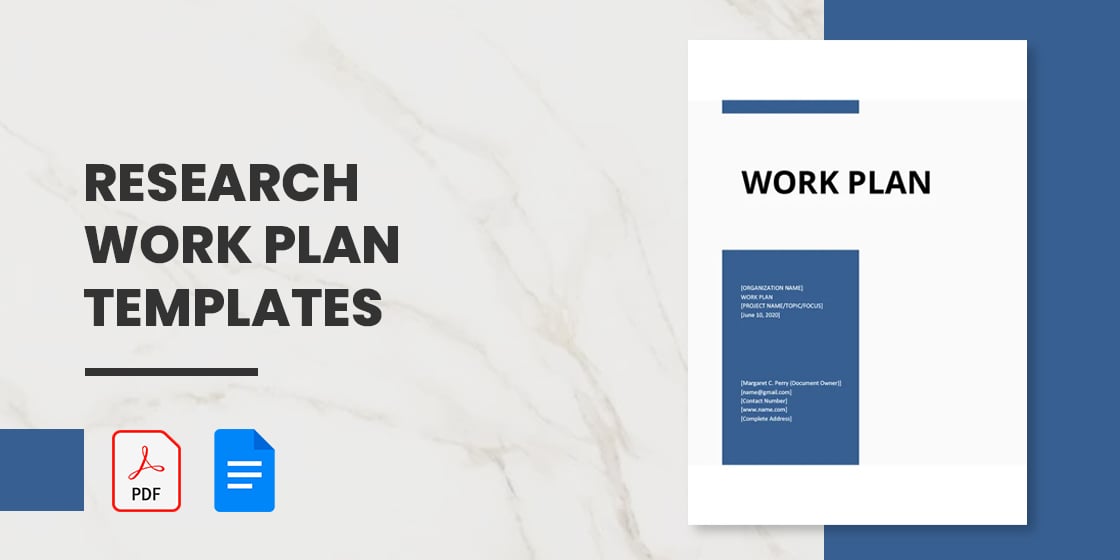
- Google Docs

- Apple Pages

Step 1: Think About the Objectives
Step 2: introduction and background, step 3: list the resources, step 4: anticipate and define limitations, step 5: assign roles, step 6: write the strategy, determine goals and objectives, organize teams and leadership, establish project timelines, set project budget, quality assurance and control, more in plan templates, research template for kids, animal research paper template, quantitative research template, educational research template, artist research template, action research template, artistic research template, longitudinal research template, prediction research template, education qualitative research template.
- 7+ Financial Plan Templates
- 10+ Operational Plan Templates
- 9+ Training Plan Templates
- 5+ Shooting Schedule Template
- 11+ School Counselor Lesson Plan Templates in PDF | Word
- 9+ Interdisciplinary Lesson Plan Templates in PDF | MS Word
- 10+ Business Continuity Plan Templates in Google Docs | Ms Word | Pages | PDF
- 18+ Compensation Plan Templates in Google Docs | MS Word | Pages | PDF
- 10+ Executive Bonus Plan Templates in PDF
- 8+ Facility Management Plan Templates in PDF
- 10+ Diversity Recruitment Plan Templates in PDF | MS Word
- 11+ Audit Corrective Action Plan Templates in MS Word | Excel | PDF
- 9+ Recruitment Agency Marketing Plan Templates in PDF
- 10+ Recruitment Marketing Plan Templates in PDF | MS Word
- 10+ Student Recruitment Plan Templates in PDF | MS Word
File Formats
Word templates, google docs templates, excel templates, powerpoint templates, google sheets templates, google slides templates, pdf templates, publisher templates, psd templates, indesign templates, illustrator templates, pages templates, keynote templates, numbers templates, outlook templates.

IMAGES
VIDEO
COMMENTS
Written by Mark Bennett. You'll need to write a research proposal if you're submitting your own project plan as part of a PhD application. A good PhD proposal outlines the scope and significance of your topic and explains how you plan to research it. It's helpful to think about the proposal like this: if the rest of your application explains ...
A PhD research plan or schedule can be prepared using the GANTT chart which includes a month, semester or year-wise planning of the entire PhD research work. First, enlist goals and objectives. It's not about your research objective enlisted in your proposal. I'm talking about the objectives of your PhD.
Example: Planning year 2 of a 3-year PhD. Maria completed her first round of data collection according to plan, and starts the second year of her PhD with a lot of material. In her second year, she will focus on turning this data into two journal articles. Months 1-2: Maria works on her data analysis.
When writing your PhD proposal you need to show that your PhD is worth it, achievable, and that you have the ability to do it at your chosen university. With all of that in mind, let's take a closer look at each section of a standard PhD research proposal and the overall structure. 1. Front matter.
A research proposal should present your idea or question and expected outcomes with clarity and definition - the what. It should also make a case for why your question is significant and what value it will bring to your discipline - the why. What it shouldn't do is answer the question - that's what your research will do.
Therefore, in a good research proposal you will need to demonstrate two main things: . 1. that you are capable of independent critical thinking and analysis . 2. that you are capable of communicating your ideas clearly . Applying for a PhD is like applying for a job, you are not applying for a taught programme.
The length of a research proposal can vary quite a bit. A bachelor's or master's thesis proposal can be just a few pages, while proposals for PhD dissertations or research funding are usually much longer and more detailed. Your supervisor can help you determine the best length for your work.
Make sure you can ask the critical what, who, and how questions of your research before you put pen to paper. Your research proposal should include (at least) 5 essential components : Title - provides the first taste of your research, in broad terms. Introduction - explains what you'll be researching in more detail.
1. Title. Your title should indicate clearly what your research question is. It needs to be simple and to the point; if the reader needs to read further into your proposal to understand your question, your working title isn't clear enough. Directly below your title, state the topic your research question relates to.
Research proposals are used to persuade potential supervisors and funders that your work is worthy of their support. These documents setting out your proposed research that will result in a Doctoral thesis are typically between 1,500 and 3,000 words in length. Your PhD research proposal must passionately articulate what you want to research and ...
Actionable PhD research plan template. Now prepare a timeline— in how much time a particular goal should be achieved. For example, 6 Months for sampling (Including, ethical approval, approval from sampling authority, consent, preparation and arrangement for utilities). Another is sample collection— 3 Months which isn't covered in the 6 ...
References: Do not forget to specify all the references at the end of the proposal. An obvious but very important point is the format of your research proposal. Make sure that the formatting of the document is consistent throughout and that the structure is clear. If possible, it can be a good idea to give the document to your academic tutor or ...
We walk you through two successful research proposals (Master's PhD-level), as well as our free research proposal. Download PDF or Word. About Us; Services. 1-On-1 Coaching. Topic Ideation; Research Proposal; Literature Review; ... Work With Us; Scholarship; Contact; All content copyright Grad Coach 2024 · The Grad Coach logo is a registered ...
Your plan includes the methodology, the sample or sources of information, a title or brief statement that helps you define and maintain your focus on the actual research tasks or problem, and an awareness of how much time the research work will take. A good PhD proposal will normally include three basic sections: the introduction to your topic ...
A comprehensive research proposal is one of the most important parts of your PhD application, as it explains what you plan to research, what your aims and objectives are, and how you plan to meet those objectives. Below you will find a research proposal template you can use to write your own PhD proposal, along with examples of specific sections.
Purpose of the PhD research plan • Develop a PhD project with realistic goals that can be achieved within the timeframe of the PhD period (normally 3-4 years). • Ensure that the PhD student and PhD supervisor(s) are aligned wrt goals of the project and the work plan/schedule. • Critically evaluate the overall objectives.
I share my PhD Research Project Plan at Oxford and how to plan your PhD research timeline using TeamGantt to stay productive and organized as a PhD student. ...
Here are a few aspects to include and remember when writing your PhD proposal: 1. Include a title page. The working title is usually around ten words long and indicates what you plan to study. Try to choose an interesting and thought-provoking title that attracts the reader's attention.
2. Create a separate title. The title of your proposal is important because it helps convey your idea and the field in which you want to work. Try to keep your title short and make it engaging and informative. You can even include relevant keywords that relate to your proposal.
What's Included: Research Proposal Template. Our free dissertation/thesis proposal template covers the core essential ingredients for a strong research proposal. It includes clear explanations of what you need to address in each section, as well as straightforward examples and links to further resources. The research proposal template covers ...
10. The work plan breaks down your project into operational steps, detailing when you will take on which task and for how long. A good work plan is feasible and complete. It signals to the committee that you are realistic and aware of the scope and practicalities of your project. It could look something like this:
A budget is a financial proposal that reflects the work proposed. It outlines the expected project costs in detail, and should mirror the project description. A budget is presented as a categorical list of anticipated project costs that represent the researcher's best estimate of the funds needed to support the proposed work. The term "best
12+ Research Work Plan Templates in PDF | MS Word. A work plan is an overview of a series of objectives and procedures by which a team and/or entity can achieve those goals and provide the reader with a clearer picture of the project's context. No matter if it is used in professional or academic life, work plans serve the purpose of helping you stay focused when working on a certain project.
G. rant. P. roposals. will be gained by direct involvement in proposal prepared by <PI name> to learn best practices, including identification of key research questions, definition of objectives, description of approach and rationale, and construction of a work plan, timeline, and budget. Postdocs and graduate students will also have access to ...